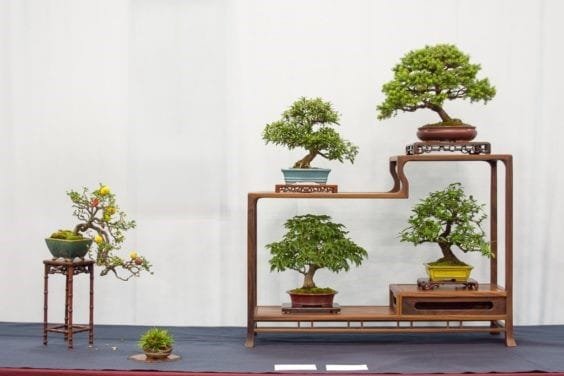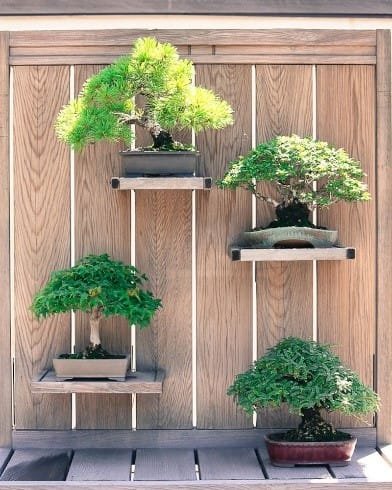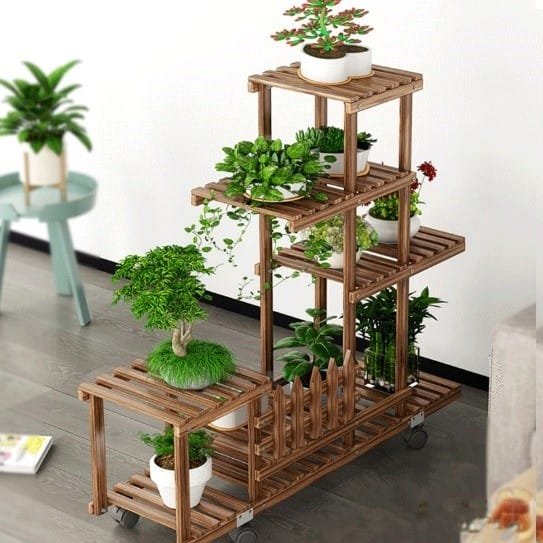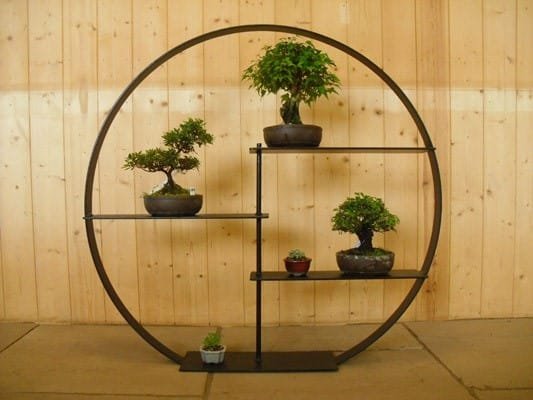Traditionally, bonsai tree masterpieces are displayed with the use of tables or stands.
Nowadays, however, the Japanese tradition and aesthetics embedded in bonsai have developed tremendously, marked by the Western approach that leaves a spectacular blueprint in combining the ancient beauty and wisdom of the art of bonsai with the modern-day spirit and trends in design and display.
If you are among the bonsai practitioners wishing to learn how to display your bonsai using shelves, there are endless options to choose from.
In fact, there are no boundaries in bonsai display shelves design, so bonsai enthusiasts can literally let their imagination run wild and reach new levels of exquisiteness when it comes to showcasing the miniature trees masterpieces in the best way possible.
Bonsai Display Shelves: A Boundless Source of Beauty & Inspiration

Bonsai shelves, also referred to as bonsai cabinets or decorative units, are relatively new to the world of bonsai. As briefly mentioned above, it is usually by opting for tables or stands how bonsai tree masterpieces are showcased.
Keeping in mind that one of the most important rules in displaying a bonsai is placing it at an eye level so that the desired emotional effect can be triggered, bonsai tables are perfectly suited based on Japanese culture and traditions.
The Japanese are known to sit directly on the floor rather than using chairs and high tables like people in the Western parts of the world. Therefore, admiring the beauty of a bonsai tree at an eye level in a Japanese setting is fully achievable through the use of tables.
In fact, sitting down is considered an art form itself in Japan, one of the most popular sitting techniques being the formal sitting position known as seiza.
Indeed, stands and benches do also make an excellent way to display a bonsai outdoors.
But for bonsai practitioners who live in an urban setting or simply wish to display their miniature tree masterpiece in a more unusual, out-of-the-box manner, bonsai shelves can be a perfect choice. Shelves can be used in both indoor, as well as an outdoor bonsai display.
Video by: juxtaposezen – Bonsai Shelves
Source: youtube.com
Properties of Fine Bonsai Shelves & Best Display Practices

Vertical bonsai shelves outdoors display – Image Source: Pinterest
As a rule of thumb, a high-quality bonsai shelf will be made out of high-quality, natural materials.
Mahogany, walnut, and rosewood can make a beautiful base material for bonsai display shelves due to their durability, sturdiness, and elegance.
Regardless of whether one makes use of stands, tables, benches or shelves for bonsai display, the basic rules remain the same: it is all about attaining balance and harmony between the elements that make up the display design.
With this in mind, shelves should be colored in naturally dark or light nuances, depending on what type of colors enhance the authentic beauty of a bonsai tree best. Bright, artificial colors must be avoided at any cost.
Nonetheless, ornamentation of the shelves should be limited as much as possible. Instead, an accent can be put on the unusual shapes of the shelves that can be further used to complement the various bonsai tree species displayed.
To illustrate this better, you can place a cascading or semi-cascading bonsai on the upper levels of the shelves, thus, creating the visual illusion of the cascading branches “flowing” downwards. It is imperative, though, to avoid overlapping of bonsai pots outside the borders of the shelf itself as not to ruin the authentic impression of a natural landscape.
When it comes to displaying Shohin bonsai trees, strong orthogonal lines can work wonders for adding an artistic flair while further enhancing the depth of the bonsai display.
In order to re-create a picturesque Shohin bonsai tree display, round-edged squared shelves can make an excellent option.
Deconstructed boxes-style shelves can also provide the much-needed element of depth when constructed with the use of posts placed at a 45-degree angle starting straight from the horizontal base of the shelf.
Although it is imperative to avoid shelves in bright colors, you can use pots in a variety of subtle nuances. When arranged and displayed together, they can harmonize and complement each other, as if one is looking at a painting rather than merely at a bonsai display box-style shelf design.
When considering how to display your bonsai using shelves, it is good to select an accent element, such as a small viewing stone. By doing so, you will add more depth and authenticity to the display.
Finally, for the innovation-minded bonsai enthusiasts, hanging plant shelves might be a brilliant way to combine bonsai aesthetics with a strong touch of an artistic flair. As if floating freely in the air, your bonsai tree masterpieces will not only evoke a sense of wonder but will also reveal another dimension of the endless beauty that the art of bonsai can reach.
Video by: Goodful – Minimalist Hanging Plant Shelf
Source: youtube.com
Final Thoughts

The world renowned Hungarian composer, conductor, music teacher, virtuoso pianist, and organist Franz Liszt shared a beautiful insight into the character of instrumental music.
According to Liszt, instrumental music has the magical power to let emotions “radiate and shine in their own character,” all without the presumption of displaying these emotions as either “real or imaginary presentations.”
In a similar manner, the art of knowing how to display your bonsai using shelves is not restricted by presumptions which affect whether or not the emotional responses of the contemplators will be triggered by real or imaginary presentations. The only thing that matters is to use bonsai shelves in such a way as to reveal the exquisite, authentic beauty of the tiny trees by conveying the infinite wisdom which resides in bonsai.


